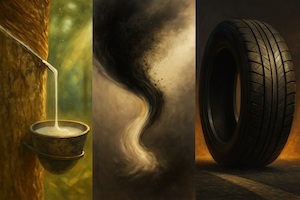Black for a Reason — a Glimpse of Wonder entry™ —
Natural rubber doesn’t begin life as a tough, black tire. It starts much softer—tapped from the slender bark of the Pará rubber tree (Hevea brasiliensis) as a milky latex. In its raw form, it appears pale—white or creamy—with subtle shades of yellow or brown depending on natural compounds like proteins or resins present in the latex (Rubber Board India).
Look even deeper, and you discover an astonishing truth: the very trees that provide this latex are themselves built from carbon. When wood dries, its dry mass is nearly half carbon by weight. Studies show wood is roughly 50 percent carbon by dry mass—sometimes as much as 47–48 percent—along with oxygen, hydrogen, and small amounts of other elements (U.S. Forest Service, Forest Carbon FAQs). That means both the source tree and the rubber latex are, in essence, carbon-rich.
Yet, untouched rubber is fragile. It’s prone to cracking under blazing sun, to breaking down in ozone-laden air, to wearing down under friction, and overheating under stress. It begs for reinforcement.
 That reinforcement comes in the form of carbon black. Produced under carefully controlled conditions through the partial combustion of hydrocarbons, this fine carbon powder is engineered to have extremely small particles with a vast surface area. When these carbon particles are blended into the latex, a powerful transformation occurs—not just in appearance, but in substance.
That reinforcement comes in the form of carbon black. Produced under carefully controlled conditions through the partial combustion of hydrocarbons, this fine carbon powder is engineered to have extremely small particles with a vast surface area. When these carbon particles are blended into the latex, a powerful transformation occurs—not just in appearance, but in substance.
The beauty lies in the compatibility—after all, the rubber and carbon black are both forms of carbon. The particles don’t dissolve into the polymer chains, but they embed themselves, gripping and anchoring them. Carbon is reinforcing carbon. It’s as if each carbon black particle extends the tree’s own molecular framework into the rubber, creating a bond that is nearly perfect on a chemical and structural level. This carbon-to-carbon marriage gives the tire the strength to stretch without tearing and to resist the constant wear of the road (Vernay – Carbon Black Reinforcement).
Following this integration, as the rubber cures, the carbon black also begins protecting the tire from heat damage—helping it shed thermal energy efficiently and endure high temperatures without degrading (CFI Carbon Products). It guards against ultraviolet light and ozone that would otherwise crack and age the rubber over time (Rubber & Seal). Some grades even provide electrical conductivity, allowing static charges to dissipate safely rather than accumulating (ASTM D257 Test Methods).
All of these fortifying effects happen invisibly—but the tire’s black color tells the story. It’s not a fashion statement. It’s proof of invisible strength, delivered in plain sight.
When Science Mirrors Spirit
Our spiritual lives start much like that pale rubber—vulnerable and in need of reinforcement. Yet the bond that makes us strong isn’t something foreign or forced. Just as carbon black blends seamlessly with the carbon-rich rubber, Jehovah’s spirit is a perfect match for who we are at our core. It doesn’t fight against our nature—it fulfills it. His spirit locks in where we are weakest, grips us where we would otherwise slip, and turns our fragility into endurance.
The reality is, when we are spiritual people, it is as if we are in step with Jehovah’s spirit. The strength that flows from that union isn’t loud or flashy, any more than a tire flaunts its blackness—it is quiet, hidden, but undeniable. It is resilience that endures pressure, heat, and wear, not because of what we are on the surface, but because of what He has worked deep within.
Isaiah 40:29 (NWT) puts it simply: “He gives power to the tired one and full might to those lacking strength.” That power doesn’t rest on us like an outer coat—it moves with us, as though it was always meant to be there.
- Mike047, Dolce vita and Roxessence
-
 1
1
-
 1
1
-
 1
1

1 Comment
Recommended Comments
Join the conversation with your brothers and sisters!
You are posting as a guest. If you are already a member, sign in now to post with your existing account.
Note: Your post will require moderator approval before it will be visible.